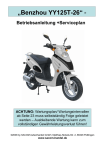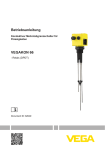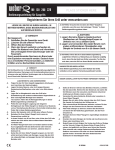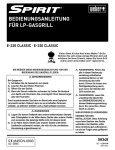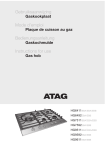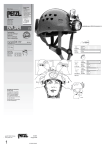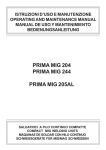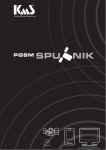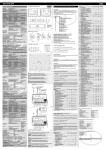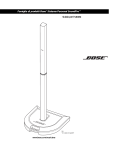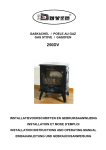Download Mode d`emploi 36001266 (000132EX) (v1)
Transcript
Gebrauchsanweisung D Fig. 1 Fig. 2 Piezo Blitz pb 1 Bitte diese Gebrauchsanweisung vor dem Produkteinsatz ausführlich lesen! 1. Einsatzbereich Der Piezo-Blitz ist ein Gasbrennerzünder für alle Brennertypen, der ohne den Einsatz von Batterien oder anderen Stromversorgungen arbeitet. 2. Merkmale und Eigenschaften Der Piezo-Blitz kann an alle Brennerrohre von Gasbrennern angeschraubt werden. Durch die Einstellbarkeit der Inbusschraube (1) kann der Piezo-Blitz dem Durchmesser der Brennerrohre individuell angepasst werden. Durch den Einsatz eines Piezo-Kristalls wird beim Piezo-Blitz ein Zündfunke iniziiert, welcher das ausströmende Gas entzündet. Der integrierte Piezo-Kristall ist völlig wartungsfrei und die Anzahl der Zündungen von keiner anderen externen oder internen Spannungsversorgung (Batterie/Netzteil) abhängig. Abb. 1 Abb. 2 3. Handling 3. Handhabung 3.1 Anbringen des Piezo-Blitz an das Brennerrohr (Standardbrenner) Die Inbusschraube (1) des Piezo-Blitz mit dem beiliegenden 3 mm-Inbusschlüssel (Best.-Nr. 140 0090 7) etwas öffnen und an das Brennerrohr ansetzen (siehe Abb. 1). Bei Brennern mit zwei Rohren (für Haupt- und Sparflamme) den PiezoBlitz an das größere der beiden Rohre anbringen. Vor dem Festziehen der Inbusschraube darauf achten, dass die Luftzufuhröffnungen (6) des Brennerrohres nicht verdeckt sind. Dabei beachten, dass die meisten Gasbrenner ein äußeres und ein inneres Brennerrohr haben. Der Zündfunke, muss vom Elektrodenende (2) zum inneren Brennerrohr (4) überspringen, um ein Zünden der Flamme zu gewährleisten. Der Abstand des Elektrodenendes (2) sollte ca. 2 bis 3 mm zur Oberkante des inneren Brennerrohres (4) betragen. Das Elektrodenende sollte nicht weiter als nötig in die brennende Flamme hineinragen, da dies zu einer übermäßigen Erwärmung des Piezo-Blitz führen kann. Der Abstand des Elektrodenendes zur Oberkante des inneren Brennerrohres kann zusätzlich mit Hilfe des beiliegenden 1,5 mm-Inbusschlüssels und der Inbusschraube (3) eingestellt werden. Dazu die Inbusschraube (3) lösen und die Drahtelektrode (2) ein wenig aus dem Isolierkörper (5) herausziehen oder hineinschieben. Die Inbusschraube danach wieder festdrehen. Zum Zünden der kleinen Gasflamme das Elektrodenende durch Drehen im Isolierkörper über dem kleinen Brennerrohr positionieren. Dazu die Inbusschraube (1) lösen und den Piezo-Blitz am großen Brennerrohr so schwenken, dass die Drahtelektrode an das kleine Brennerrohr herangeführt wird. Beim längeren Arbeiten mit der Sparflamme kann es zu einer Erwärmung des großen Brennerrohres der Hauptflamme und somit auch des Piezo-Blitz kommen. Dies tritt jedoch nur ein, wenn sich die Brennerrohre an der Spitze berühren. Darauf achten, dass kleines und großes Brennerrohr an der Brennerrohrspitze mindestens 0,5 mm Abstand haben, um die Wärme des Brennerrohres nicht überleiten zu können. 3.2 Anbringen des Piezo-Blitz bei voluminösen Brennerköpfen Bei Brennern mit extrem voluminösem Brennerkopf (Abb. 2) kann ein normaler Klammerdraht (ø 0,8 mm) gebogen werden, welcher den Zündfunken an den Brennerkopf führt. Dabei beachten, dass der Draht weit genug im Isolierkörper eingeführt wird und im Verlauf genügend Abstand zum Brennerrohr hat. Der Funke springt immer am kleinsten Abstand zwischen Brennerrohr und Drahtelektrode über. 4. Zünden der Gasflamme Bei Brennern mit zwei Rohren (Hauptflamme/Sparflamme) und Wahlhebel wird die Drahtelektrode über dem Brennerrohr platziert, mit welchem am häufigsten gearbeitet wird. Den Haupthahn für die Gaszufuhr öffnen, den Wahlhebel in die Position bringen, die das Gas aus dem Brennerrohr ausströmen lässt, welches gezündet wird und 5 bis 10 sek. warten, bis die Luft aus der Gasleitung und dem Brenner ausgespült wurde. Den Zündknopf (7) drücken und das ausströmende Gas zünden. Nachdem die Flamme brennt, kann der Wahlhebel entweder auf Haupt- oder auf Sparflamme umgestellt werden. Eine Oxydation der Drahtelektrode hat keinen Einfluß auf die Funktionstüchtigkeit des Piezo-Blitz. 5. Sicherheits- und Gefahrenhinweise - Beim Betätigen des Zündknopfes und gleichzeitigem Anfassen der Drahtelektrode kommt es zu einem Stromschlag für den Körper. Die Spannungsspitze, welche durch den Piezo-Blitz erreicht wird, liegt zwar bei mehreren tausend Volt, doch die Ströme, die dabei fließen können, sind äußerst gering. Somit führt ein Stromschlag zwar zu keinem Gesundheitsrisiko, wird aber als unangenehm empfunden. - Der Piezo-Blitz sollte deshalb nur an Metallbrennern betrieben werden. Hier wird der Stromkreis Piezo-Blitz/ Brenner in sich geschlossen und der Funke springt automatisch immer zwischen Drahtelektrode und Brenner über. 6. Sonstige Hinweise Die Angaben dieser Gebrauchsanweisung werden stets den aktuellsten Ergebnissen und Erfahrungen angepasst. Wir empfehlen daher, vor Benutzung einer neuen Packung die Gebrauchsanweisung zu lesen. Diese Gebrauchsanweisung bezieht sich auf Piezo-Blitz pb 1 Best.-Nr. 360 0126 6. Ausgabe: 23.01.03/0D Instructions for use 3.1 Attaching the Piezo-Blitz to the burner pipe (standard burner) Loosen the Allen screw (1) of the Piezo-Blitz slightly using the enclosed 3 mm Allen key (Order No. 140 0090 7) and attach it to the burner pipe (see Fig. 1). If burners with two pipes are used (for main and economy flame), attach the Piezo-Blitz to the larger one of the two pipes. Before fastening the Allen screw, it must be ensured that the air inlet openings (6) of the burner pipe are left uncovered. Please note that most gas burners have an outer and an inner burner pipe. The ignition spark must jump from the end of the electrode (2) to the inner burner pipe (4) to ensure that the flame is ignited. The end of the electrode (2) should be approx. 2 to 3 mm away from the upper edge of the inner burner pipe (4). The end of the electrode should not protrude too much into the burning flame since this may result in excessive heating of the Piezo-Blitz. The distance of the end of the electrode to the upper edge of the inner burner pipe can also be adjusted using the enclosed 1.5 mm Allen key and the Allen screw (3). For this purpose, the Allen screw (3) is loosened and the wire electrode is pulled out slightly from the insulator (5) resp. slid slightly into the insulator (5). Then the Allen screw is tightened again. To ignite the small gas flame, turn the end of the electrode in the insulator to position it above the small burner pipe. For this purpose, loosen the Allen screw (1) and turn the Piezo-Blitz at the large burner pipe in a way that the wire electrode is moved closely to the small burner pipe. When working with the economy flame over a longer period, heating of the large burner pipe of the main flame and thus also of the Piezo-Blitz may result. This, however, will only occur if the tips of the burner pipes come into contact with each other. Make sure that the small and the large burner pipe have a minimum distance of 0.5 mm at the tip of the burner pipe to avoid transfer of the heat of the burner pipe. 3.2 Attaching the Piezo-Blitz to voluminous burner heads When using burners with extremely voluminous burner heads (fig. 2), a standard clasp wire which feeds the ignition spark to the burner head (ø 0,8 mm) can be bent. It must be ensured that the wire is inserted deep enough into the insulator and that there is sufficient distance between the wire and the burner pipe. The spark always jumps at the point of the smallest distance between the burner pipe and the wire electrode. 4. Igniting the gas flame In the case of burners with two pipes (main flame/economy flame) and selector, the wire electrode is positioned above the burner pipe with which most of the work is carried out. Open the main valve for the gas supply, put the selector in the position in which the gas escapes from the burner pipe; after gas starts to escape, wait 5 to 10 s until the air has been removed from the gas line and the burner. Press the ignition button (7) to ignite the escaping gas. When the flame is burning, the selector can either be adjusted to main or economy flame mode. Oxidation of the wire electrode will not affect the functional efficiency of the Piezo-Blitz. 5. Safety information and hazard warnings - Simultaneous pressing the ignition button and touching the wire electrode will result in an electric shock. The voltage spike that is reached by the Piezo-Blitz may amount up to several thousand volts; the resulting currents, however, are extremely low. Accordingly, an electric shock does not cause a health hazard, however it may cause an unpleasant feeling. - The Piezo-Blitz should only be used with metal burners. In this case the electric circuit is closed in itself and the spark always automatically jumps between the wire electrode and the burner. 6. Additional information The information contained in these instructions for use is always updated according to the latest results and experience. Therefore we recommend to read the instructions for use again before using a new package. These instructions for use refer Piezo-Blitz pb 1, Order No. 360 0126 6. edition: 23.01.03/GB Mode d`emploi F Piezo-Blitz pb 1 Veuillez lire attentivement ce mode d`emploi avant d’utiliser le produit! 1. Champ d’application Piezo-Blitz est un allumeur pour tous les types de brûleur à gaz. Il fonctionne sans pile et sans courant électrique. 2. Caractéristiques et propriétés Piezo-Blitz peut être vissé sur toutes les rampes de brûleur. La vis à six pans creux (1) étant réglable, il est possible d’adapter le Piezo-Blitz au diamètre du brûleur utilisé. Grâce à l’emploi d’un cristal Piezo, une étincelle est amorcée sur le Piezo-Blitz qui permet d’enflammer le gaz en sortie. Le cristal Piezo intégré ne demande aucun entretien et fonctionne en mode autonome (ni pile, ni courant électrique). Ill. 1 Ill. 2 GB Piezo-Blitz pb 1 Befor using this product, please read these instruction for use carefully! 1. Indication range The Piezo-Blitz is an ignitor for all types of gas burners and does not require batteries or any other type of power supply. 2. Components and features The Piezo-Blitz can be screwed on to all burner pipes of gas burners. Since the Allen screw (1) is adjustable, the PiezoBlitz can be adapted individually to the diameter of the burner pipes. An integrated piezo crystal starts an ignition spark which ignites the escaping gas. The integrated piezo crystal is entirely maintenance-free and the number of ignitions does not depend on any other external or internal source of power supply (battery/mains adaptor). 3. Manipulation 3.1 Montage du Piezo-Blitz sur la rampe du brûleur (brûleur standard) Ouvrir légèrement la vis à six pans creux (1) du Piezo-Blitz à l’aide de la clé à six pans creux 3 mm (N° de cde 140 0090 7) et la monter sur la rampe du brûleur (voir Ill. 1). Pour les brûleurs à deux rampes (pour grande et petite flamme), monter le Piezo-Blitz sur la rampe la plus grosse. Avant de serrer la vis veiller à ce que les arrivées d’air (6) de la rampe du brûleur ne soient pas obstruées. Attention: la plupart des brûleurs à gaz ont une rampe externe et interne. L’étincelle doit jaillir de l’extrémité de l’électrode (2) en direction de la rampe interne (4) pour garantir l’allumage de la flamme. La distance entre l’extrémité de l’électrode (2) et le bord supérieur de la rampe interne du brûleur (4) doit être d’env. 2 à 3 mm. L’extrémité de l’électrode ne doit pas entrer au contact de la flamme plus que nécessaire afin d’éviter une surchauffe du Piezo-Blitz. Weissenhorner Str. 2 • 89250 Senden • Germany • Tel. (+49) 0 73 09 / 8 72-22 • Fax (+49) 0 73 09 / 8 72-24 www.bredent.com • e-mail [email protected] La distance entre l’extrémité de l’électrode et le bord supérieur de la rampe interne du brûleur peut aussi être réglée à l’aide de la clé à six pans creux 1,5 mm et la vis à six pans creux (3) jointes. Pour ce faire, dévisser la vis (3) et dégager légèrement l’électrode (2) du corps isolant (5) ou l’enfoncer davantage. Bien resserrer ensuite la vis à six pans creux. Pour allumer la petite flamme, positionner l’extrémité de l’électrode sur la petite rampe du brûleur en la faisant pivoter dans le corps isolant. Pour ce faire, dévisser la vis (1) et incliner le Piezo-Blitz situé sur la grande rampe du brûleur de façon à ramener l’électrode au niveau de la petite rampe du brûleur. Lorsque l’on travaille longtemps avec la petite flamme, la grande rampe et donc le Piezo-Blitz risquent de chauffer. Cela ne se produit toutefois que lorsque les rampes du brûleur se touchent à leur extrémité. Veiller à maintenir une distance d’au moins 0,5 mm entre les extrémités des rampes afin d’éviter tout transfert thermique des rampes. 3.2 Montage du Piezo-Blitz sur des têtes de brûleur volumineuses Avec des brûleurs à tête volumineuse (Ill. 2), on peut plier un fil à crochet classique (ø 0,8 mm) qui servira à guider l’étincelle au niveau de la tête du brûleur. Veiller à introduire le fil suffisamment dans le corps isolant et le conserver suffisamment à distance de la rampe. L’étincelle jaillit toujours là où la distance est la plus courte entre la rampe et l’électrode. 5. Consigli sulla sicurezza ed informazioni sui rischi - Al momento dell’azionamento del tasto di accensione ed alla contemporanea scarica di corrente del filo dell’elettrodo il corpo può subire una scossa elettrica. La punta di tensione, che si raggiunge con il Piezo-Blitz, è di parecchie migliaia di Volt, ma le correnti, che possono scorrere, sono estremamente ridotte. Perciò una scossa elettrica non causa rischi alla salute, ma può essere comunque sgradevole. - Il Piezo-Blitz dovrebbe perciò essere utilizzato solo su bruciatori in metallo. In questo caso il circuito elettrico PiezoBlitz/bruciatore è racchiuso all’interno e la scintilla scocca automaticamente tra il filo dell’elettrodo e il bruciatore. 4. Allumage de la flamme Avec les brûleurs à deux rampes (grande et petite flamme) et un levier de sélection, l’électrode se positionne sur la rampe du brûleur la plus utilisée. Ouvrir le robinet d’alimentation en gaz, mettre le levier dans la position qui permet au gaz de sortir de la rampe et attendre 5 à 10 s jusqu’à ce que l’air soit purgé de la conduite de gaz et du brûleur. Appuyer sur le bouton d’allumage (7) et allumer le gaz en sortie. Après allumage de la flamme, on peut placer le levier soit sur la grande flamme soit sur la petite. L’oxydation de l’électrode n’a aucun impact sur le fonctionnement du Piezo-Blitz. Folleto de instrucciones 5. Consignes de sécurité et identification des dangers - Le fait de d’actionner à la fois la tête d’allumage et de toucher l’électrode provoque une décharge de courant dans le corps. La pointe de tension atteinte par Piezo-Blitz est effectivement de plusieurs milliers de volts mais les courants qui s’en échappent sont extrêment faibles. Une décharge de courant n’est donc pas dangereuse mais désagréable. - C’est la raison pour laquelle Piezo-Blitz ne doit être utilisé que sur des brûleurs métalliques. Dans ce cas, le courant entre le Piezo-Blitz et le brûleur est en circuit fermé et l’étincelle jaillit automatiquement et toujours entre l’électrode et le brûleur. 6. Divers Les indications contenues dans ce mode d’emploi sont constamment révisées en fonction des dernières connaissances et expériences acquises. Nous vous conseillons donc de relire le mode d’emploi avant d’utiliser un nouveau produit. Ce mode d’emploi concerne Piezo-Blitz pb 1 N° de cde 360 0126 6. édition : 23.01.03/0F Istruzioni per l’uso 6. Ulteriori indicazioni I consigli e le avvertenze contenute in queste istruzioni d’uso sono aggiornati di continuo alle nuove conoscenze ed esperienze. Vi consigliamo quindi di leggere nuovamente le istruzioni d’uso del prodotto, prima di utilizzare una nuova confezione. Queste istruzioni d’uso si riferiscono al prodotto Piezo-Blitz cod. nr. 360 0126 6. edizione: 23.01.03/0I Piezo-Blitz pb 1 E Rogamos lean la hoja de información sobre el producto antes de usar el producto. 1. Campo de uso El Piezo-Blitz es un encendedor de gas para todos los tipos de mecheros de gas, sin tener que utilizar baterías u otros utensilios electrónicos de encendido. 2. Argumentos y características El Piezo-Blitz se puede colocar en cualquier tupo de mechero de cualquier mechero de gas. Gracias al tornillo con cabeza a Allen (1) se puede adaptar el diámetro del Piezo-Blitz al cualquier tubo de mechero. Por medio del cristal del Piezo se encenderá el Piezo-Blitz una chispa, que enciende el gas del mechero. El cristal integrado del Piezo no hace falta mantenimiento y las veces que se pueden encender no dependen de ningún elemento externo ó interno (baterias/corriente). Imagen 1 Imagen 2 I Piezo-Blitz pb 1 Leggere attentamente le istruzioni prima dell’utilizzo del prodotto. 1. Campo d’impiego Il Piezo-Blitz è un dispositivo di accensione per tutti i tipi di bruciatori a gas, che non necessita dell’utilizzo di batterie o di altri fonti di energia. 2. Proprietà e caratteristiche Il Piezo-Blitz può essere avvitato su tutti i cannelli dei bruciatori. Grazie alla possibilità di regolazione della vite ad esagono cavo (1) il Piezo-Blitz può essere adattato individualmente al diametro del cannello. Grazie all’utilizzo di un piezo-cristallo, nel Piezo-Blitz si crea una scintilla di accensione, che provvede all’accensione del gas emesso. Il piezo-cristallo integrato non richiede nessuna manutenzione ed il numero di accensioni non dipende da nessuna fonte di energia interna od esterna (batterie/rete elettrica). Disegno 1 Disegno 2 3. Modalità d’impiego 3.1 Inserimento del Piezo-Blitz sul cannello (bruciatore standard) Svitare leggermente la vite ad esagono cavo (1) del Piezo-Blitz con l’apposita chiave da 3 mm., in dotazione (Cod. nr. 140 0090 7), e posizionarla sul cannello (vedi disegno 1). Nel caso di bruciatori a due cannelli (per fiamma principale e fiamma piccola) inserire il Piezo-Blitz sul più grande dei due cannelli. Prima di fissare la vite, fare attenzione che il foro (6) di emissione dell’aria non sia coperto. Inoltre fate attenzione, che la maggior parte dei bruciatori a gas hanno un tubo esterno ed uno interno. Per poter garantire l’accensione della fiamma, la scintilla di accensione, deve passare dall’estremità dell’elettrodo (2) al tubo interno (4). La distanza tra l’estremità dell’elettrodo (2) e l’angolo superiore del tubo interno (4) dovrebbe essere di ca. 2 - 3 mm. L’estremità dell’elettrodo non dovrebbe sporgere all’interno della fiamma viva più del necessario, poiché, ciò può causare un surriscaldamento eccessivo del Piezo-Blitz. La distanza tra l’estremità dell’elettrodo e l’angolo superiore del tubo interno può essere aumentata con l’aiuto della chiave da 1,5 mm, in dotazione, e la vite ad esagono cavo (3). A tale scopo, svitare la vite ed estrarre o sospingere leggermente il filo dell’elettrodo dal corpo dell’isolatore. Dopodiché fissare nuovamente la vite. Per l’accensione della fiamma piccola, posizionare l’estremità dell’elettrodo sul cannello piccolo, con una rotazione nel corpo dell’isolatore. Svitare la vite (1) e ruotare il Piezo-Blitz sul cannello grande fin tanto che, il filo dell’elettrodo venga spostato sul cannello piccolo. In caso di accensioni prolungate della fiamma piccola può crearsi un surriscaldamento del cannello grande della fiamma principale e pertanto anche del Piezo-Blitz. Ciò però avviene solo, se i cannelli si toccano sulla punta. Perciò fare attenzione, che la punta del cannello piccolo e grande siano ad una distanza minima di 0,5 mm, per poter evitare il passaggio di calore. 3.2 Inserimento del Piezo-Blitz su teste di bruciatori voluminose Nel caso di bruciatori con teste estremamente voluminose (disegno 2) può essere piegato un normale filo a graffa (ø 0,8 mm), che crea la scintilla di accensione sulla testa del cannello. Fare attenzione, che il filo sia sufficientemente introdotto nel corpo dell’isolatore e che sia abbastanza distante dal cannello. La scintilla scocca sempre sulla distanza più piccola tra il cannello e il filo dell’elettrodo. 3. Manejo 3.1 Colocación del Piezo-Blitz en el tubo del mechero (mechero estándar) Abrir el tornillo con cabeza de Allen (1) del Piezo-Blitz con la llave Allen de 3 mm (Nºde Ref: 140 0090 7) que incluye en el paquete; abrir algo el tornillo y ajustarlo al tubo (ver imagen 1). Si el mechero tuviese dos tubos (llama principal y de ahorro) se colocará el Piezo-Blitz en el tubo más grande .Antes de cerrar el tornillo tener en cuenta que el escape de aire este libre (6).Tener en cuenta que la mayoría de los mecheros tiene dos tubos uno externo y otro interno. La chispa de encendido deberá sobrepasar el final del electrodo (2) al tubo interior (4), para garantizar un encendido correcto. La distancia del final del electrodo (2) de 2 a 3 mm del canto superior del tubo (4). El final del electrodo no deberá ser introducido demasiado para evitar el sobrecalentamiento del Piezo-Blitz. La distancia del final del electrodo con respecto al canto superior del tubo interior de mechero se podrá ajustar por medio de la llave Allen de 1 y el tornillo con cabeza de Allen (3). Para realizar esto aflojar el tornillo (3) y sacar algo el alambre del elctrodo (2) del cuerpo aislante (5) ó introducirlo algo. A continuación cerrar el tornillo de nuevo. Para encender la llama pequeña girar el final del electrodo del cuerpo aislante y posicionarlo sobre el tubo del mechero. Para ello aflojar el tornillo de cabeza Allen (1) y girar el Piezo-Blitz del tubo grande al tubo pequeño, que el electrodo pequeño se introduzca en él. Si se trabajase durante mucho tiempo con la llama pequeña de ahorro se podrá producir un calentamiento del tubo grande, también del Piezo-Blitz. Esto solo se producirá si los dos se tocan por la parte superior. A tener en cuenta que los dos tubos tengan una distancia de 0,5mm, para evitar la transmisión del calor entre ellos. 3.2 Colocación del Piezo-Blitz en tubos voluminosos En mecheros con una cabeza de calentamiento voluminoso (imagen 2) se podrá doblar un alambre normal (ø 0,8 mm),que vaya a la cabeza del mechero. Tener en cuenta que el alambre doblado se introduzca lo máximo posible en el cuerpo de aislamiento y tenga una distancia suficiente con respecto al tubo del mechero. La chispa siempre saltará a la mínima distancia entre el tubo el electrodo del alambre. 4. Encendido de la llama de gas Con mecheros de dos tubos (llama principal/ llama de ahorra) y con palanca de elección se colocará el Piezo-Blitz sobre el tubo con el se trabaje constantemente. Abrir el grifo principal de gas, posicionar la palanca de elección por donde se quiera que salga el gas y esperar 5 a 10 seg., hasta que haya salido el aire del tubo. Encender el botón de encendido (7) y encender el gas saliente del tubo. Una vez que se haya encendido la llama, se podrá posicionar la palanca de elección en la llama principal ó de ahorro. Una oxidación del alambre no tendrá ninguna influencia sobre el funcionamiento del Piezo-Blitz. 5. Consejos de seguridad y peligrosidad - Durante la manipulación del botón de encendido y si se tocase el alambre de electrodo, se podrá producir una pequeña descarga eléctrica para el cuerpo. La tensión que se pueda conseguir por medio del Piezo-Blitz esta entre miles de voltios, pero la electricidad que pueda fluir, es muy pequeña. Se podrá producir una pequeña molestia para la saludo, solo se sentirá como algo incomodo. - El Piezo-Blitz solo se deberá coloca en mecheros metálicos. Así se cierra el circulo de electricidad del Piezo-Blitz/ mechero y la chispa saltará automáticamente entre el electrodo del alambre y el mechero. 6. Consejo adicional La información sobre el producto se acoge a los últimos resultados y experiencias sobre el mismo. Por ello aconsejamos antes de su uso leer de nuevo la información sobre el producto. Esta información sobre el producto se refiere a l PiezoBlitz pb 1 Nºde Ref. 360 0126 6. edición: 23.01.03/0E Weissenhorner Str. 2 • 89250 Senden • Germany • Tel. (+49) 0 73 09 / 8 72-22 • Fax (+49) 0 73 09 / 8 72-24 www.bredent.com • e-mail [email protected] 000132EX 4. Accensione della fiamma a gas Nei bruciatori con due cannelli (fiamma principale/fiamma piccola) e con leva di selezione, il filo dell’elettrodo viene posizionato sul cannello, con il quale si lavora con maggiore frequenza. Aprire il rubinetto principale per la fuoriuscita del gas, mettere la leva di selezione sulla posizione, che consente al gas di fuorisuscire dal cannello, il quale viene acceso ed attendere da 5 a 10 sec., fino a che l’aria si vanifichi dalla conduttura del gas e dal cannello. Premere il tasto di accensione (7) ed accendere il gas emesso. Dopo che la fiamma brucia, la leva di selezione può essere spostata sia sulla fiamma principale che sulla fiamma piccola. Un’ossidazione del filo dell’elettrodo non influisce sul funzionamento del Piezo-Blitz.



